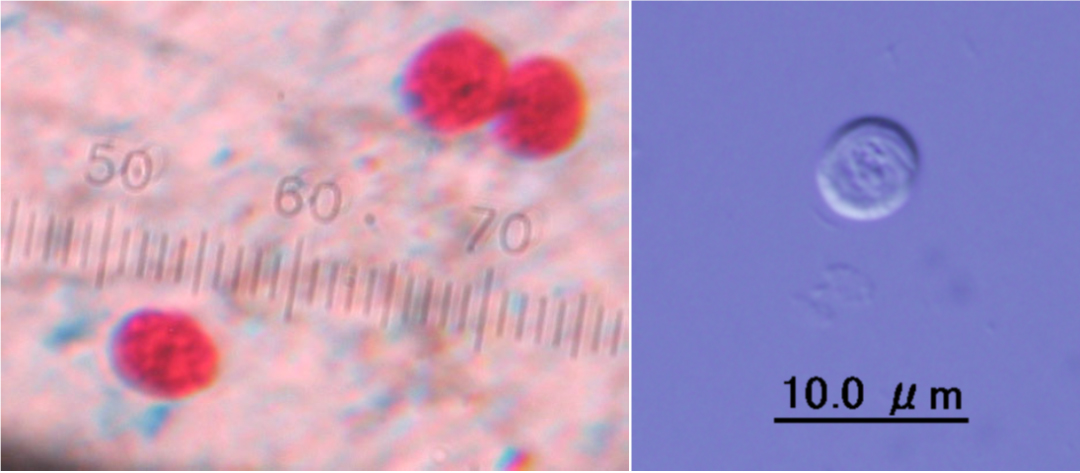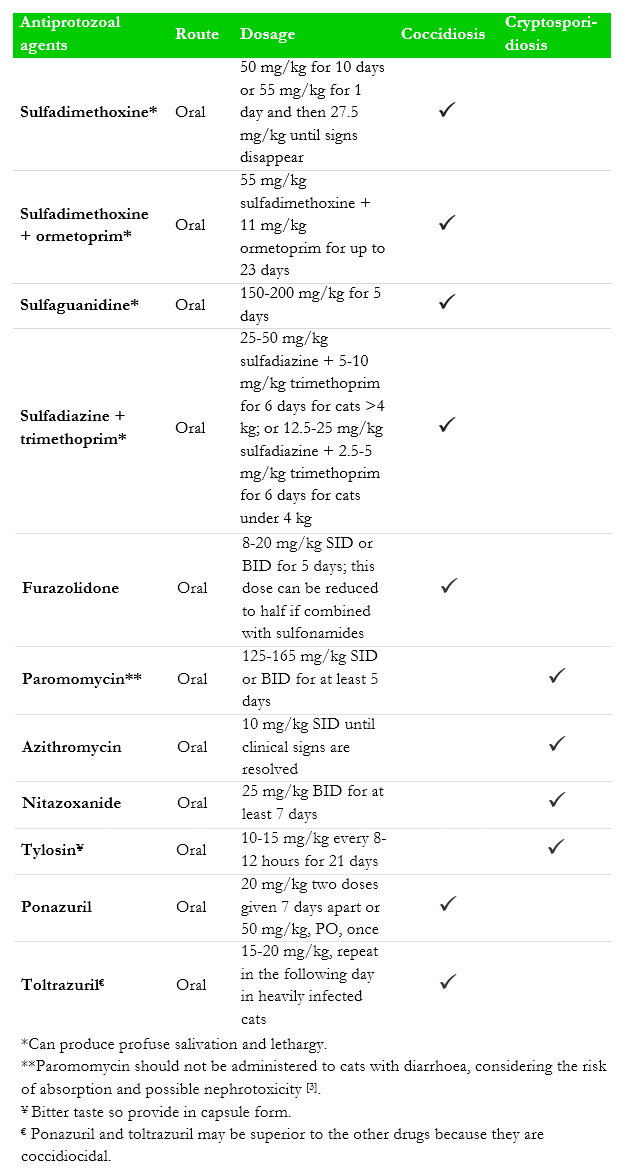Cryptosporidium
(Cryptosporidium spp.)
Cryptosporidium spp. are intestinal coccidia that may infect a wide range of hosts, including cats. Cryptosporidium spp. infecting cats are zoonotic.
Distribution
Worldwide.
Clinical signs
In most cases, Cryptosporidium felis infection in cats is asymptomatic. The majority of symptomatic cases of cryptosporidiosis manifest as watery diarrhoea and have been reported in cats with immune suppression or coinfection with other agents, for example feline leukaemia virus, feline immunodeficiency virus or Tritrichomonas foetus [1].

Figure 1. Cryptosporidium oocysts in cat faeces. A: Acid-fast staining of faecal smear. B: unstained faecal floation (Image credit: Dr. B. K. Linh)
Diagnosis
Cryptosporidium spp. infections in cats can be confirmed using the modified Ziehl-Neelsen staining technique (SOP 6). Oocysts are 3.5-5 μm in diameter in C. felis and 5 μm in diameter in C. parvum (Fig. 1). A direct immunofluorescent antibody assay (IFA) that simultaneously detects Giardia cysts and Cryptosporidium oocysts in dog and cat faeces is commercially available (Merifluor Cryptosporidium/Giardia; Meridian Bioscience, Inc., Cincinnati, OH) and is reputed to be more sensitive than traditional microscopic examination. PCR for the detection and quantification of Cryptosporidium DNA is also considered extremely sensitive and is offered by commercial labs in some countries.
Treatment
For antiprotozoal treatment options, refer to Table 2.
Table 2. Routes of administration, dosage and efficacies of commonly utilised antiprotozoal agents against coccidiosis and cryptosporidiosis of cats [1.2]
Prevention and Control
Good hygienic practices, regular washing of cages, and the washing of bedding in a regular washer and drier will destroy oocysts, which are killed when exposed to high temperature (over 60°C). Contaminated surfaces can be soaked for 20 minutes in 3% hydrogen peroxide (99% kill rate) and then rinsed thoroughly. Commercial disinfectant options include soaking surface in 10% Ox-Virin (hydrogen peroxide plus peracetic acid) for 1 hr, 3% Ox-Agua (hydrogen peroxide plus silver nitrate) for 30 min, an amine-based formula Keno-Cox 2-3% for 2 hours, cresol-based compounds including Neopredisan 135-1 and Aldecoc TGE (4% for 2 hours) [3]. Concentrated ammonia solutions (50%) can inactivate Cryptosporidium oocysts after 30 minutes, however care is required when handling this product as it is toxic.
Public health considerations
Cryptosporidium felis is a potential zoonoses but is responsible for less than 3% of total reported human cases [4,5]. Cryptosporidium felis has been isolated from HIV-positive adults and healthy children [4]. Therefore, immunocompromised individuals and children should be advised to minimise contact with cat faeces and practice high standards of personal hygiene.
References
[1] Scorza V, Tangtrongsup S. Update on the diagnosis and management of Cryptosporidium spp infections in dogs and cats. Top Companion Anim Med. 2010;25:163-169.
[2] Lappin M. Update on the diagnosis and management of Isospora spp. in dogs and cats. Top Companion Anim Med. 2010;25:133-135.
[3] Naciri M, Mancassola R, Forta G, Danneelsb B, Verhaegheb J. Efficacy of amine-based disinfectant KENO™COX on the infectivity of Cryptosporidium parvum oocysts. Vet Parasitol. 2011;179:43-49.
[4] Lucio-Forster A, Griffiths JK, Cama VA, Xiao L, Bowman DD. Minimal zoonotic risk of cryptosporidiosis from pet dogs and cats. Trends Parasitol. 2010;26:174-179.
[5] Ebner J, Koehler AV, Robertson G, Bradbury RS, Jex AR, Haydon SR, Stevens MA, Norton R, Joachim A, Gasser RB. Genetic analysis of Giardia and Cryptosporidium from people in Northern Australia using PCR-based tools. Infect Genet Evol. 2015;36:389-395

